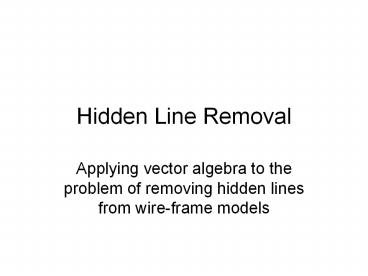Hidden Line Removal - PowerPoint PPT Presentation
Title:
Hidden Line Removal
Description:
Hidden Line Removal. Applying vector algebra to the problem of removing hidden ... So visible faces can be drawn in any order. Examples: barn, cube, and dodecahedron ... – PowerPoint PPT presentation
Number of Views:36
Avg rating:3.0/5.0
Title: Hidden Line Removal
1
Hidden Line Removal
- Applying vector algebra to the problem of
removing hidden lines from wire-frame models
2
Convex objects
- We first focus on modeling convex objects
- One outward face cannot hide another
- So visible faces can be drawn in any order
- Examples barn, cube, and dodecahedron
3
A non-convex object
part of this face is hidden by that face
eye of viewer
4
2D Polygons in 3D space
- A polygon is a 2-dimensional figure
- Its edges and corner-points are coplanar
- Its a bounded region of an infinite plane
- Any plane in 3-space can be described by an
first-degree (linear) algebraic equation ax
by cz d - Alternatively, using vector algebra, a plane can
be described using a reference-point Q and a
direction-vector N (a, b, c), as N QP 0
5
Face-Planes of solid objects
- Any plane surface has two sides
- When a plane is a surface of a solid object it
has an inside surface and an outside surface
(a viewer sees the outside one)
front
back
viewer
6
Angles and cosines
- An angle of 90-degrees is a right angle
- Angles less than 90-degrees are acute
- And angles over 90-degrees are obtuse
obtuse angle
right angle
acute angle
cosine lt 0
cosine gt 0
cosine 0
7
Vectors and dot-products
- Vectors u (ux, uy, uz) and v (vx, vy, vz)
have a dot-product - uv ux vx uy vy uz vz
- A vectors length u equals sqrt( uu )
- A dot-product is related to the cosine of the
angle ? between the two vectors uv
uvcosine(?) - So sign of dot-product tells angles type
8
Visibility of face-planes
N outward pointing normal vector
N
D
?
DN gt 0 (acute angle ?)
outer surface is visible
D direction vector (from plane toward viewers
eye)
9
Hidden face-plane
N outward pointing normal vector
N
?
D
DN lt 0 (obtuse angle ?)
outer surface is hidden
D direction vector (from plane toward viewers
eye)
10
Format of models data-set
- Added data needed to describe our model
- Number and Location of vertices as before
- Edge-list is no longer needed (zero edges)
- Face-list is the new information to be add
- Each face is a polygon number of sides, list of
vertices in counter-clockwise order (as viewed
from the outside of the model), and the
face-color to be used for the face
11
Example data-set cube
7
0
Face-List (6 faces)
3
4
4-sided 0, 1, 2, 3 (blue) 4-sided 1, 0,
7, 6 (green) 4-sided 2, 5, 4, 3
(cyan) 4-sided 4, 5, 6, 7 (red) 4-sided
6, 5, 2, 1 (magenta)
6
1
5
2
The vertices of each face should be listed in
counterclockwise order (an
seen from the outside of the cube)
12
Why counterclockwise order?
- We need to compute the outward-pointing normal
vector for each polygonal face (to determine if
that outward face is visible) - That normal vector is easily computed (as a
vector cross-product) if the vertices were listed
in counterclockwise order
13
Recall the cross-product uv
- If u ( ux, uy, uz ) and v ( vx, vy, vz ),
then w uv is given by these formulas wx
uyvz uzvy wy uzvx uxvz wz uxvy
uyvx - Significance cross-product w makes a
90-degree angle with both u and v (so its
normal to a plane containing u and v)
14
Three consecutive vertices
pq
p v1 v0 q v2 v1
V1
q
p
V2
V0
pq will be the outward-pointing normal
vector (if v0, v1, v2 occurred in
counterclockwise order)
15
Demo program
- Our filldemo.cpp application reads in the data
for a 3D model, determines which of its polygonal
faces are visible to a viewer, fills each visible
face in its specified color, and then draws the
edges of visible faces - Datasets plato.dat, redbarn.dat, plane.dat
- Also two models for a non-convex object
corner1.dat and corner2.dat (same object)
16
In-class exercises
- Try to create the data-sets for some more
interesting 3D objects, (by writing a C
program to generate the objects vertices and the
face-lists) - Example An octagonal prism
- Divide a circle into eight equal-size angles
- Use sine and cosine to locate upper vertices
- Use sine and cosine to locate lower vertices
- Use number-patterns to generate its ten
face-planes































